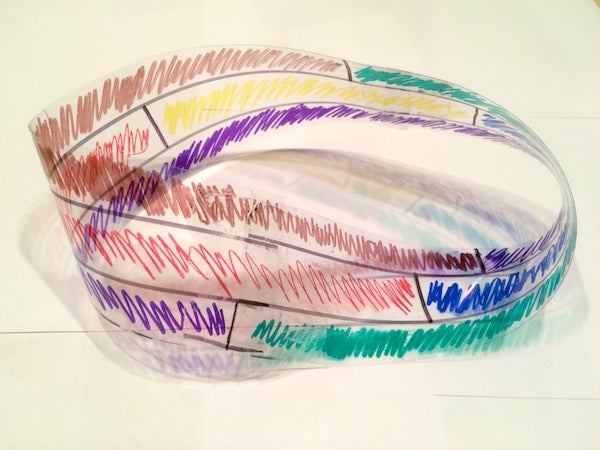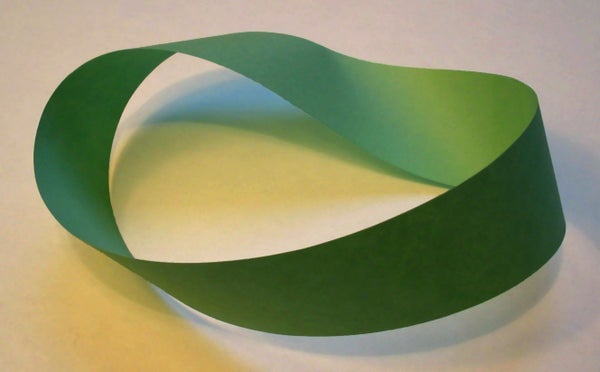This article was published in Scientific American’s former blog network and reflects the views of the author, not necessarily those of Scientific American
If you hang around with mathematicians or go to math outreach programs, you’ve probably seen a Möbius strip, or Möbius band. It has a special place in the pop math world because it’s easy to make, fun to play with, and holds some surprising mathematical secrets.
You can make a Möbius band in the comfort of your own home by taking a strip of paper or pasta dough, putting a half twist in it, and taping (paper) or squishing (pasta) the ends together. It’s like a cylinder, but a little off. If you're a knitter or crocheter, you may be able to make one that's wearable.
We often use the Möbius strip to illustrate the topological property of orientability. Orientability is one of those things you know when you see but is kind of tricky to define. I don’t remember how many times I stared at the definition of orientation from one of my textbooks: “a continuous choice of local orientation.” I found this explanation incredibly unhelpful. Why would the definition of the word orientation contain the word orientation?
On supporting science journalism
If you're enjoying this article, consider supporting our award-winning journalism by subscribing. By purchasing a subscription you are helping to ensure the future of impactful stories about the discoveries and ideas shaping our world today.
A more intuitive way to understand orientability, at least for a two-dimensional object in three-dimensional space, is that a space is orientable if you can choose “inward” and “outward” or “up” and “down” directions at every point on the surface that are compatible: you will never accidentally end up at the same point but with “up” flipped to “down.”
Perhaps the most intuitive way to understand it is just to play with a sphere or cylinder and a Möbius strip. For example, if you're using a sphere, at the North pole you can declare that the “outward” direction points straight up. As you move around the sphere, the “outward” direction is still pointing out of the sphere. In contrast, try to choose an “up” and a “down” on a Möbius band. When you slide along the band, you eventually wind up at the same point you started at, but “up” has become “down.” Although you made it out of normal paper with a front and a back, you’ve lost sidedness. You can get from the front to the back of the paper by moving in a straight line rather than turning the paper over.
There are many mathematical curiosities twisted into the Möbius band. A classic activity is to cut it in half and see what you get. What about thirds? What if you put some extra half-twists into it? It's an activity that is more fun to do at home or with your Girl Scout troop than to read on a blog.
The property of the Möbius strip that I learned most recently is the six-color theorem. You may have heard of the four-colortheorem: any map can be colored using four distinct colors so that no bordering countries share a color. This theorem is not quite true as stated. We need to specify that the map is on a sphere or plane. Different surfaces have different ___-color map theorems, and for the Möbius strip, it's the six-color map theorem.
To make this theorem work, remember that a Möbius strip, like any good mathematical object, is an idealized creature that can't live in our messy real world. It's two-dimensional, not three-dimensional like actual sheets of paper. There isn't any thickness separating the front from the back. To visualize this, you might want to make your Möbius band out of a transparency sheet. That way, when you draw your map, you can't color the two sides of the paper different colors at any one point. If you draw maps on both sides of a piece of paper and then make a Möbius band out of it, the four-color theorem from the plane will apply instead.
Here I have a little picture of a map on a Möbius strip that requires six colors. It’s probably hard to see this on your computer screen, so instead of taking my word for it, you might want to play along at home.

A map requiring six colors on a Möbius strip. Image: Evelyn Lamb
The Möbius band is appealing to artists as well as mathematicians. You can make or buy Möbius strip scarves, pendants, and rings. You can play Möbiusmusic. Its storytelling potential is clear: you travel around something, only to end up back where you started but disoriented. Up becomes down, in becomes out. Perhaps the most beautiful use of the Möbius strip as a storytelling device is Vi Hart’s touching story of Wind and Mr. Ug, two friends who can’t quite seem to meet each other in person.
Read about more of my favorite spaces: The Cantor Set Fat Cantor Sets The Topologist’s Sine Curve Cantor's Leaky Tent The Infinite Earring The Line with Two Origins The House with Two Rooms The Fano Plane The Torus The Three-Torus The Long Line Space-Filling Curves
